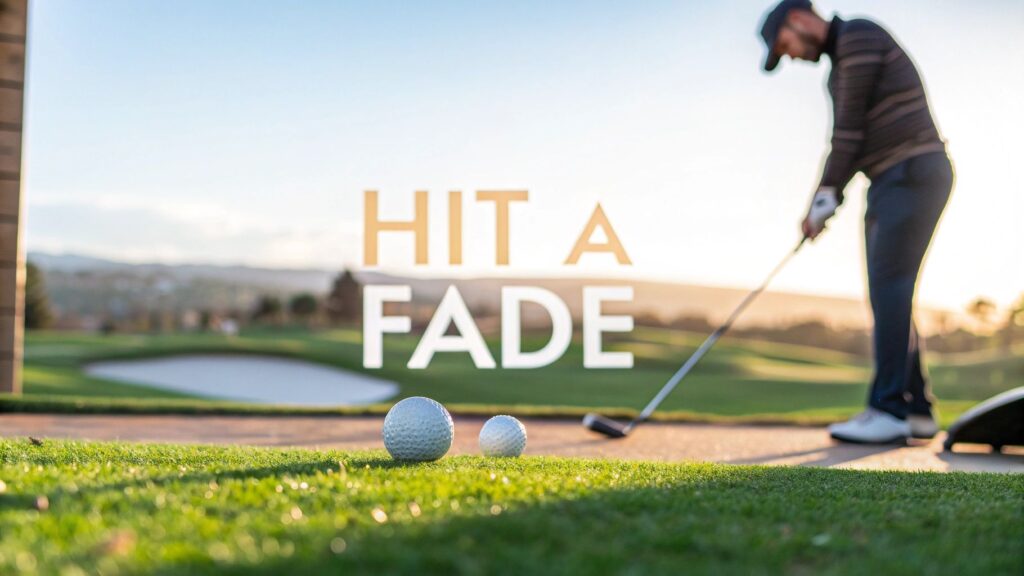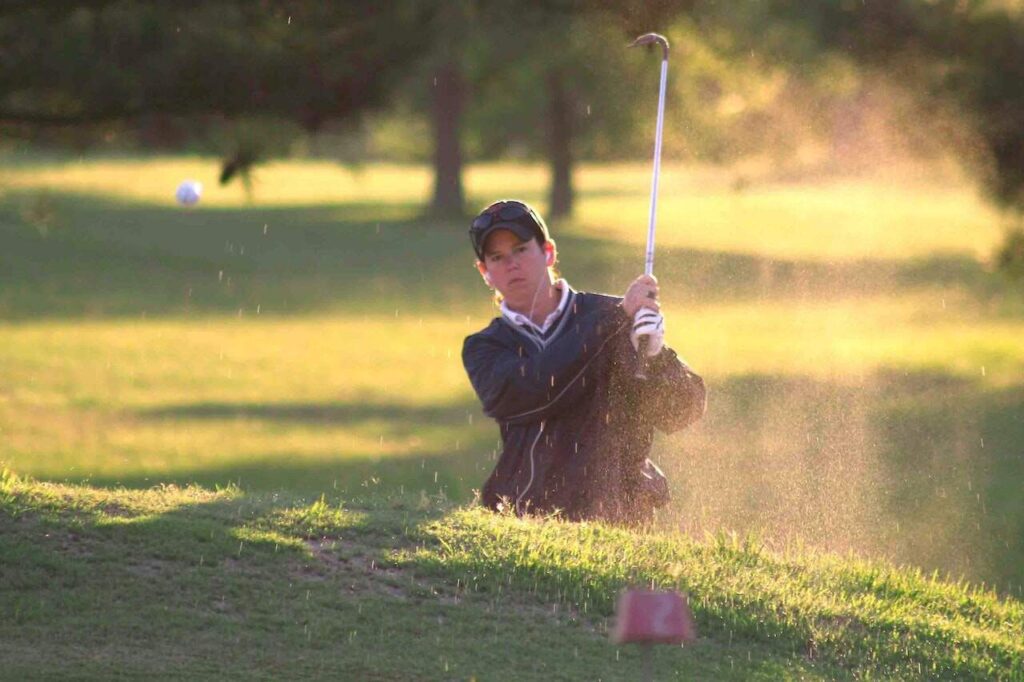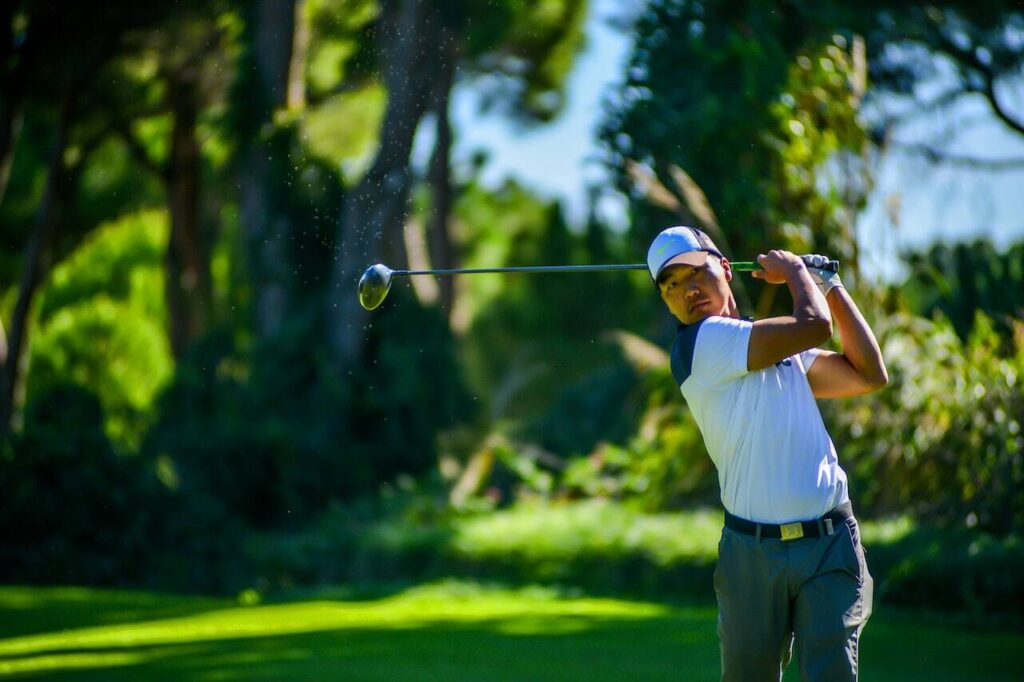To hit a controlled fade, you need two key ingredients: an out-to-in swing path relative to your target line, and a clubface that’s slightly open to that path when you make contact. This combo is what puts that gentle, predictable left-to-right spin on the ball for a right-handed player and is crucial for understanding how to hit a fade effectively. Understanding how to hit a fade can significantly enhance your performance on the course. When you want to learn how to hit a fade, it’s important to practice consistently.
Why a Controlled Fade Is a Game Changer in Golf
Before we dive into the nitty-gritty, let’s talk about why adding a reliable fade to your arsenal is one of the smartest things you can do for your game. Most amateurs hear “fade” and immediately think of the dreaded slice, but a controlled fade is a different beast entirely. It’s a precision tool the best players in the world use for a reason.
This isn’t just about bending the ball around a tree; it’s about gaining strategic control and predictability, especially when the pressure is on. This one shot can totally transform how you manage your way around the course, turning what used to be a nerve-wracking hole into a genuine scoring opportunity.
Picture this: you’re standing on the tee of a sharp dogleg right. Instead of trying to thread a perfect straight shot or risking a massive miss, you can just step up and play a confident fade that hugs the shape of the fairway. The ball lands softly, setting you up perfectly for your approach. That’s playing golf, not just hitting a ball.
The Power of Predictability in Golf
One of the fade’s biggest assets is just how reliable it is. Historically, it’s been the go-to shot shape for many top pros because it offers so much control, especially on tough, modern course layouts. Tiger Woods, for example, famously used a fade as his stock shot during some of the most dominant stretches of his career because he could count on it under the gun.
A fade starts just a little left of your target and then curves gently back towards it, usually only moving a few yards. A slice, on the other hand, is an uncontrolled, exaggerated curve that sends you searching in the rough. You can find more insights on the fade over at englandigolf.co.uk.
A fade is often called the “CEO’s shot” for a reason—it’s dependable, it pretty much eliminates the big miss to one side of the course, and it consistently leaves you in a good spot.
Strategic Advantages on the Golf Course
The benefits of playing a fade go way beyond just hitting more fairways. Its unique flight characteristics make it the perfect choice in a bunch of real-world scenarios you face in every single round.
Learning to hit a fade gives you a powerful new tool for:
- Attacking Tucked Pins: Got a pin tucked on the right side of the green, right behind a bunker? A fade is your best friend. You can start the ball safely over the middle of the green and just let it drift softly toward the flag.
- Holding Firm Greens: Fades naturally produce more backspin than draws. That higher spin rate means the ball lands much softer and stops quicker, giving you way more control on firm, fast greens.
- Avoiding Trouble: Since a fade moves away from a righty’s body, it often feels more natural and helps eliminate that destructive hook to the left. By committing to one shot shape, you can essentially take one entire side of the golf course out of play.
Golf: Building Your Fade from the Ground Up
You don’t manufacture a reliable fade in the middle of a frantic downswing. It’s not about last-second manipulations with your hands. Instead, a great fade is born in the quiet moments before you even start the club back. The real secret to hitting a fade on command lies in your setup—a few small tweaks to your grip, stance, and alignment that basically pre-program the ball flight you’re looking for.
The Golf Grip: Your First Move
It all starts with your hands. To encourage a fade, you need to adopt what’s called a “weak” grip. Now, this has nothing to do with how hard you squeeze the club. It’s all about the rotational position of your hands on the handle.
For a right-handed golfer, this just means turning both hands a touch to the left (counter-clockwise). At address, you should see fewer knuckles on your left hand—maybe one or two at most. This simple adjustment makes it much harder to roll your wrists and close the clubface through the ball, which naturally leaves it slightly open to your swing path at impact.
Here’s what that weak grip should look like.
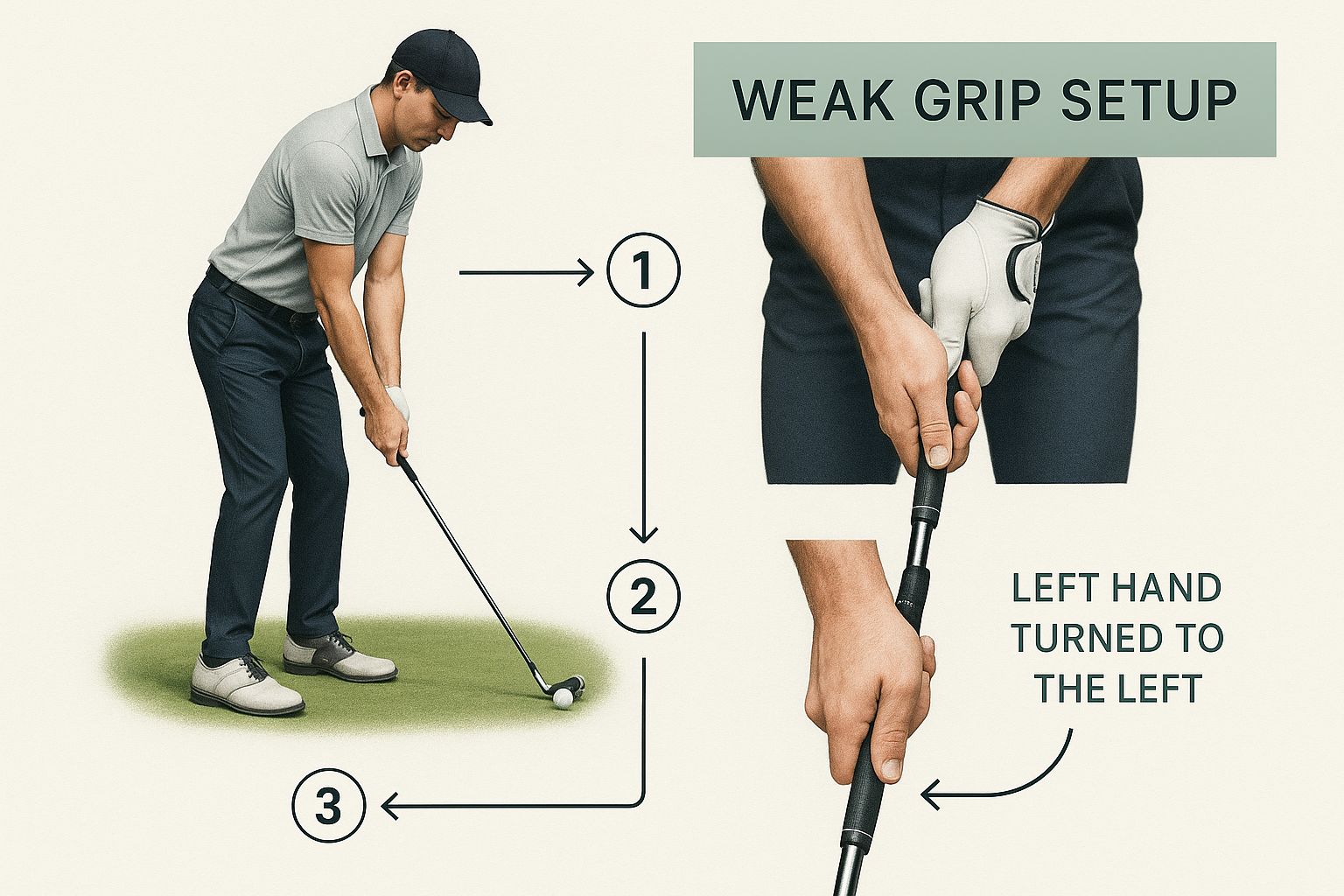
This slight rotation of your hands is the first domino to fall. It sets the club in a position that favors that beautiful left-to-right shape.
Golf: Aligning for the Curve
Once your grip is sorted, your body alignment is the next piece of the puzzle. Hitting a fade requires an out-to-in swing path relative to your target. The easiest, most repeatable way to create this path is to simply aim your body left of your target (for right-handers).
I like to think of it as setting up on two separate train tracks. One track is your target line, pointed straight at the flag. The other track is your body line—feet, hips, and shoulders—which should be aligned on a track pointing slightly left of the pin.
By aligning your body left while keeping the clubface pointed at the target, you’ve essentially pre-loaded the exact relationship between swing path and face angle needed for a perfect fade.
This “open” stance encourages you to swing along your body line, which automatically produces that out-to-in motion. It’s a much more reliable method than trying to reroute the club on the fly. You just set up open, and make your normal swing. The setup does all the heavy lifting for you.
Your Pre-Shot Checklist in Golf
To really lock this in, it helps to run through a quick mental checklist on the range. The differences in setting up for a fade versus a straight shot are subtle but absolutely critical. Keep in mind that a faster swing can sometimes exaggerate these movements, so if you are working on how to improve your golf swing speed, being mindful of these setup keys is even more important. When discussing how to hit a fade, consider the mental aspect. Visualization can enhance your focus and technique.
To make it crystal clear, here’s a quick comparison of the two setups.
Golf Fade Setup vs Straight Shot Setup
This table breaks down the small but crucial adjustments between setting up for a controlled fade and a standard, straight shot. Pay attention to how each element works together to produce the desired ball flight.
| Setup Element | Fade Shot Adjustment | Straight Shot Standard |
|---|---|---|
| Grip | Hands rotated slightly left (weaker) on the club. | A neutral grip with 2-3 knuckles visible on the top hand. |
| Alignment | Feet, hips, and shoulders are aimed left of the target. | Feet, hips, and shoulders are parallel to the target line. |
| Clubface | Aimed directly at the final target. | Aimed directly at the target, square to the body line. |
| Ball Position | Can be slightly forward of center to help the club move left. | Typically in the center for mid-irons, slightly forward for longer clubs. |
Using this as a guide on the driving range will help you build the muscle memory needed to take this shot confidently to the course.
Executing the Swing for a Perfect Fade in Golf
With your setup dialed in, it’s time to groove the swing motion itself. All the pre-shot adjustments have put you in the perfect position to hit that fade; now, the goal is to make a swing that feels natural and athletic. Let those setup keys do the work for you.
The focus here is on creating that crucial “out-to-in” swing path without making a wild, uncontrolled lunge at the ball.
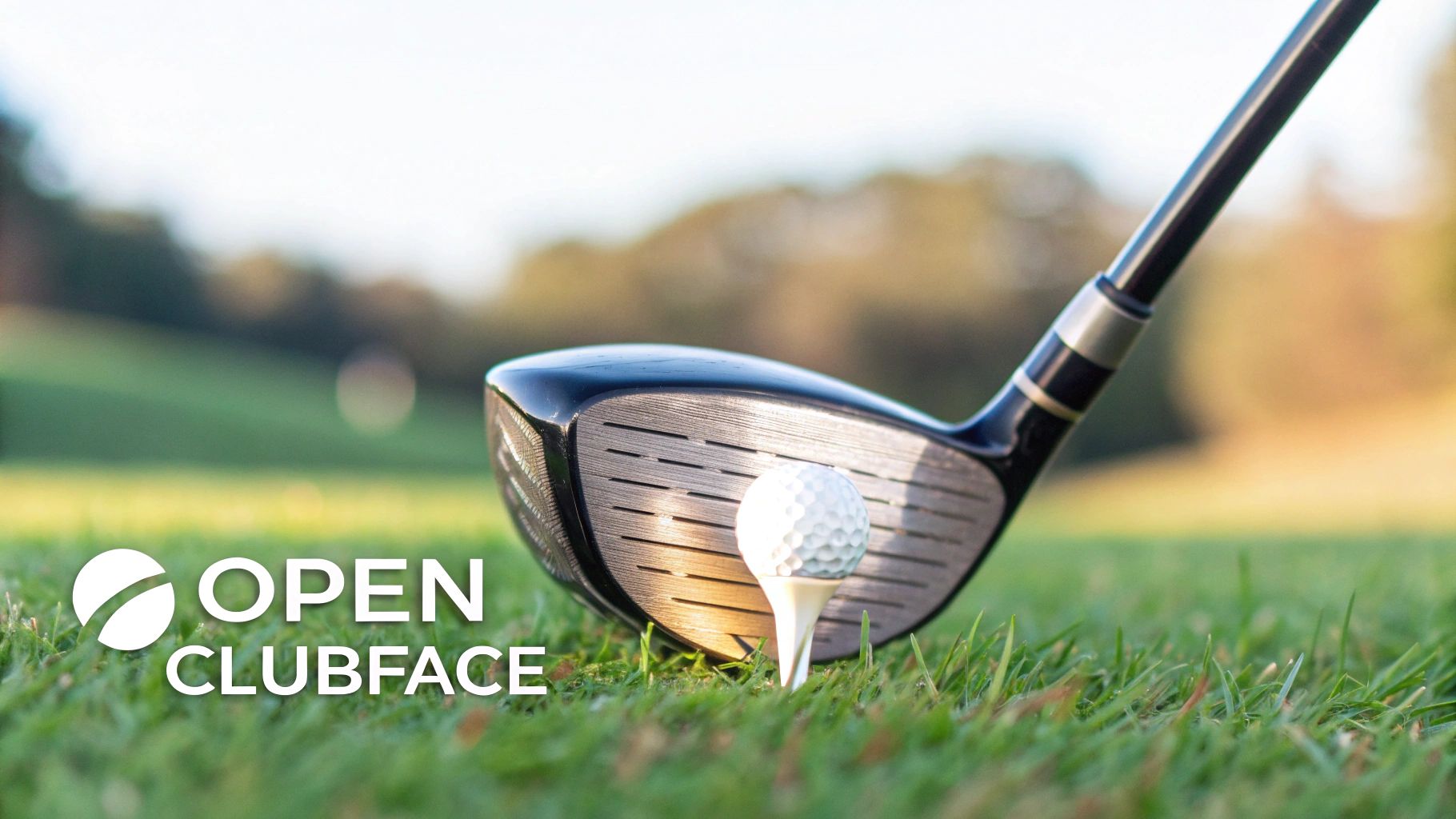
The feeling you’re chasing is simple: swing along your body line, not the target line. Since you’ve already aimed your feet, hips, and shoulders left of the pin, a swing that feels “normal” will naturally travel on this out-to-in path. There’s no need to consciously steer or reroute the club.
Controlling the Golf Club Path
The term club path simply describes the direction your clubhead is moving at impact. To produce a fade, you need what we call a negative club path value (for a righty), which just means the club is moving to the left of the target line through the hitting zone.
This is where most amateurs trying to hit a fade go wrong. They make the huge mistake of throwing the club “over the top” with their shoulders and arms on the downswing. That’s a classic slice move—steep, weak, and totally out of control.
Instead, a great swing thought is to feel like you’re keeping your back turned to the target for just a split-second longer as you start the downswing. This simple move helps the club drop into a powerful position and encourages your body, not just your arms, to lead the swing.
Managing Your Hand Release in Golf
Just as important as your swing path is what your hands are doing through impact. Remember that weaker grip we established in the setup? It’s specifically designed to prevent your hands from rolling over too aggressively, which would shut the clubface and turn your beautiful fade into a nasty pull.
Your goal is to feel a “quiet” hand release. Imagine your hands and the clubhead moving through the impact zone as one stable unit.
Think of it like a firm handshake with the ball. You’re not trying to flip or twist your wrists at the last moment. You simply want to hold off the rotation of the clubface, allowing it to stay open to your swing path and produce that perfect, cutting spin.
Practical Golf Range Drills
Building the muscle memory for this swing takes repetition. Here are a couple of classic drills you can take to the driving range to make the fade swing feel like second nature.
- The Gate Drill: Place two headcovers or alignment sticks on the ground to create a “gate” for your club to swing through. For a fade, you’ll want to position the gate so it forces your club to approach the ball from the outside and exit to the inside. Hitting the ball cleanly without striking either marker is proof that your path is on the right track.
- The Body Line Swing: Lay an alignment stick on the ground parallel to your foot line (which should be pointing left of the target). Now, just practice making swings where you feel the club travels parallel to that stick through impact. This drill is fantastic for reinforcing the feeling of swinging along your body’s alignment rather than trying to force the club down the target line.
By combining the right setup with a swing that follows your body line and a quiet hand release, you’ll develop a consistent, reliable fade you can trust on any hole.
Golf: Understanding Fade Ball Flight and Distance
Knowing how to hit a fade is one thing. To really use it as a weapon on the course, you need to understand what the ball is actually doing in the air and, just as importantly, how it reacts when it hits the ground. A fade isn’t just about making the ball curve; it’s about controlling its flight, spin, and final destination.
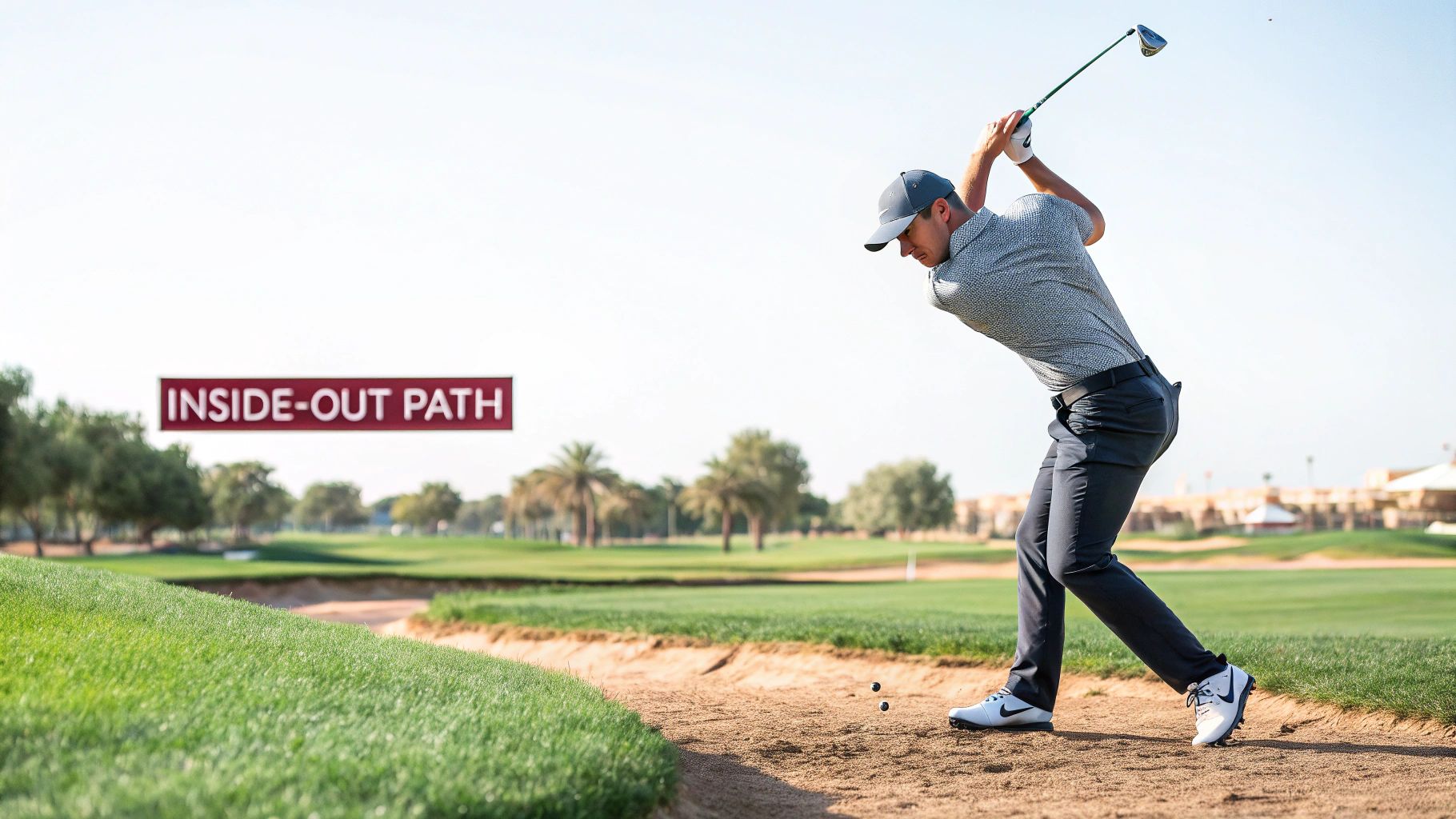
The physics are pretty straightforward. That out-to-in swing path, paired with a clubface that’s slightly open to that path, puts more backspin on the ball than a draw does. This extra spin is precisely what makes a fade such a valuable tool for course management. More spin means a slightly higher ball flight and—this is the key—a much softer landing with very little rollout. By remembering how to hit a fade and practicing regularly, you will see significant improvements in your game.
Spin and Control: The Fade’s Secret Golf Weapon
That higher spin rate is your ticket to attacking tricky pin locations. Picture a pin tucked right behind a bunker on a firm green. A lower-spin shot like a draw might land near the hole but then release and roll right off the back. A well-hit fade, on the other hand, almost parachutes down, takes a small hop or two, and stops.
This “stopping power” is why you see so many pros favor it, especially under pressure. It gives them the confidence to fly the ball all the way to their target, knowing it will sit down quickly. It turns hopeful approach shots into calculated attacks on the flagstick.
The real advantage of a fade isn’t the curve itself, but the control that comes with it. Higher spin means a softer landing, giving you the ability to hold greens that other shots can’t.
Golf: Carry vs. Total Distance: Unpacking the Numbers
This brings us to a critical concept every golfer needs to grasp: the difference between carry distance and total distance. A draw might roll out and give you a few extra yards on the scorecard, but the fade is king when it comes to predictable carry.
The data backs this up. Let’s look at how the numbers shake out for a fade versus a draw, assuming a consistent clubhead speed.
Fade vs. Draw Performance at 100 MPH Club Speed
| Metric | Fade | Draw |
|---|---|---|
| Carry Distance | 222 yards | 224 yards |
| Total Distance | 249 yards | 258 yards |
| Spin Rate (RPM) | High | Low |
| Landing | Soft | Firm (more roll) |
You can see the trade-off clearly. While the draw travels a bit farther overall (258 yards vs. 249 yards), that nine-yard difference is almost all roll. The carry distances are nearly identical. If you want to dive deeper, you can find more data on draws vs. fades to really understand these performance differences.
Understanding this is what separates good decisions from bad ones on the course. Need to carry a water hazard or a deep bunker? The fade’s reliable carry is your best friend. Facing a wide-open fairway where you need every yard you can get? A draw might be the smarter play. This knowledge is what empowers you to choose the right shot at the right time.
Common Fade Mistakes and How to Fix Them in Golf
When you’re trying to groove a new shot shape, a few bad shots are just part of the process. Don’t sweat it. The real skill is learning how to diagnose what went wrong on the fly so you can get back on track without creating bad habits. Let’s look at the most common problems golfers run into when trying to hit a fade and give you some simple, actionable ways to fix them. Additionally, watching professional golfers and their techniques on how to hit a fade can provide great insights.
The Fade That Turns Into a Slice in Golf
This is the big one, isn’t it? You’re aiming for a gentle, controlled fade, but instead, you get a wild, power-sapping slice that dives hard to the right. This almost always comes down to one of two things: your out-to-in swing path got way too steep, or your clubface was wide open at impact.
A classic cause for this is the dreaded “over-the-top” move, where your shoulders and arms lunge at the ball to start the downswing.
- The Fix: Stop trying to force the club outside. Instead, let your setup do the work. Make sure your body—feet, hips, and shoulders—is aligned left of the target, but keep that clubface pointing right at your target. This setup presets the perfect path. From there, just feel like you’re swinging right along your shoulder line. It’s that simple.
A slice is just a fade on steroids. It’s born from an imbalance where you have too much out-to-in path or a clubface that’s way too open. The goal is to moderate these elements, not exaggerate them into chaos.
The Golf Ball That Starts Left and Stays Left
So, you’ve nailed the out-to-in path, but now the ball starts left of your target and just keeps going. That’s a classic “pull.” It’s a clear signal that your clubface was closed relative to your target when you hit the ball.
Basically, your swing path went left, and the clubface was pointing left along with it. The ball had no other choice but to follow that path.
This usually happens if your grip is too strong (your hands are rotated too far to the right) or if you’re too “handsy” through impact, causing the clubface to snap shut.
- The Fix: First, check your grip. You’re probably looking for a weaker, more neutral grip. Try to see only one or two knuckles on your top hand. Next, as you swing through the ball, focus on a quieter hand release. Think about “holding off” the rotation of the clubface for just a split second longer than you normally would.
Simple Drills for a Consistent Fade in Golf
Knowing what’s wrong is half the battle, but fixing it for good takes practice. To build better muscle memory and avoid these common fade mistakes, you need drills that give you instant feedback. There are tons of great options out there, and you can explore a whole collection of golf swing practice drills to see what clicks for you. In conclusion, mastering how to hit a fade will not only improve your game but also increase your enjoyment on the course. Ultimately, the secret to how to hit a fade lies in consistent practice and fine-tuning your swing mechanics. For golfers seeking to refine their skills, knowing how to hit a fade properly can be a game-changer. It provides the ability to navigate challenging course layouts with confidence.
Here’s a dead-simple drill to help tame an overly aggressive swing path:
- Alignment Stick Guide: Lay an alignment stick on the ground just outside your golf ball, running parallel to your target line.
- The Goal: Your only job is to make swings without hitting that stick on the way down.
- The Feedback: If you come over the top too steeply, you’ll smack the stick every time. This drill forces you to shallow out your swing and approach the ball on a much more controlled out-to-in path—the perfect recipe for a reliable fade.
FAQ’S
Even when you’ve got the setup and swing thoughts dialed in, trying to groove a consistent fade can bring up a few questions. Trust me, I’ve heard them all out on the range. Getting some clear answers is usually the final piece of the puzzle that turns practice into performance. Let’s dig into what golfers ask most when they’re learning this shot.
Is a Fade Just a Controlled Slice?
Not quite, but it’s easy to see why people connect the two. While both shots curve from left-to-right (for a righty), that’s where the similarity ends.
A fade is your friend. It’s an intentional shot with a gentle, predictable curve that you can rely on. It starts a touch left of your target and then softly drifts back toward it, landing with control. A slice, on the other hand, is the enemy—an uncontrolled miss caused by a major swing flaw. It results in that big, banana-ball curve that kills your distance and sends you searching in the trees.
Think of it this way: a fade is a surgeon’s scalpel, used for precision. A slice is a sledgehammer, causing unpredictable damage. The goal is to refine your technique to produce the former, not the latter.
Will I Lose Distance If I Hit a Fade?
This is probably the biggest concern I hear, and the answer is: you might see a small drop in total distance, but the trade-off is almost always worth it.
Fades naturally generate more backspin than draws. This means the ball will land softer and won’t roll out as much. The thing is, your carry distance—how far the ball actually flies in the air—is usually very close to what you’d get with a draw. For most golfers, it’s a no-brainer:
You Gain: A huge amount of control over your ball flight and the ability to stop the ball quickly on the greens.
You Lose: Maybe a few yards of roll you might have gotten from a lower-spinning draw.
When you’re firing at pins, that accuracy and stopping power are far more valuable than a few extra yards of rollout.
What’s the Best Club to Learn a Fade With?
When you’re first trying this out, grab a mid-iron. A 7-iron or 8-iron is the perfect tool for the job. These clubs give you a great blend of loft and length, making them forgiving enough to learn with without being too demanding.
The loft helps you actually see the curve of the ball in the air, which gives you immediate feedback on whether your adjustments are working. It’s much easier to shape a shot with these than with a long iron or, especially, a driver. Once you feel comfortable hitting a fade with your mid-irons, you can take that same feel and apply it to your longer clubs and eventually the driver.
At Golf Inquirer, we believe that understanding the nuances of shots like the fade is what takes your game to the next level. Join us at Golf Inquirer to explore more about how to hit a fade and other techniques to elevate your game. Explore more tips and deepen your passion for golf with us. Learn more at https://golfinquirer.com.

